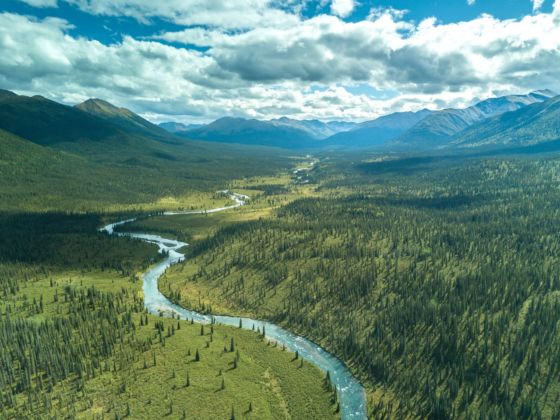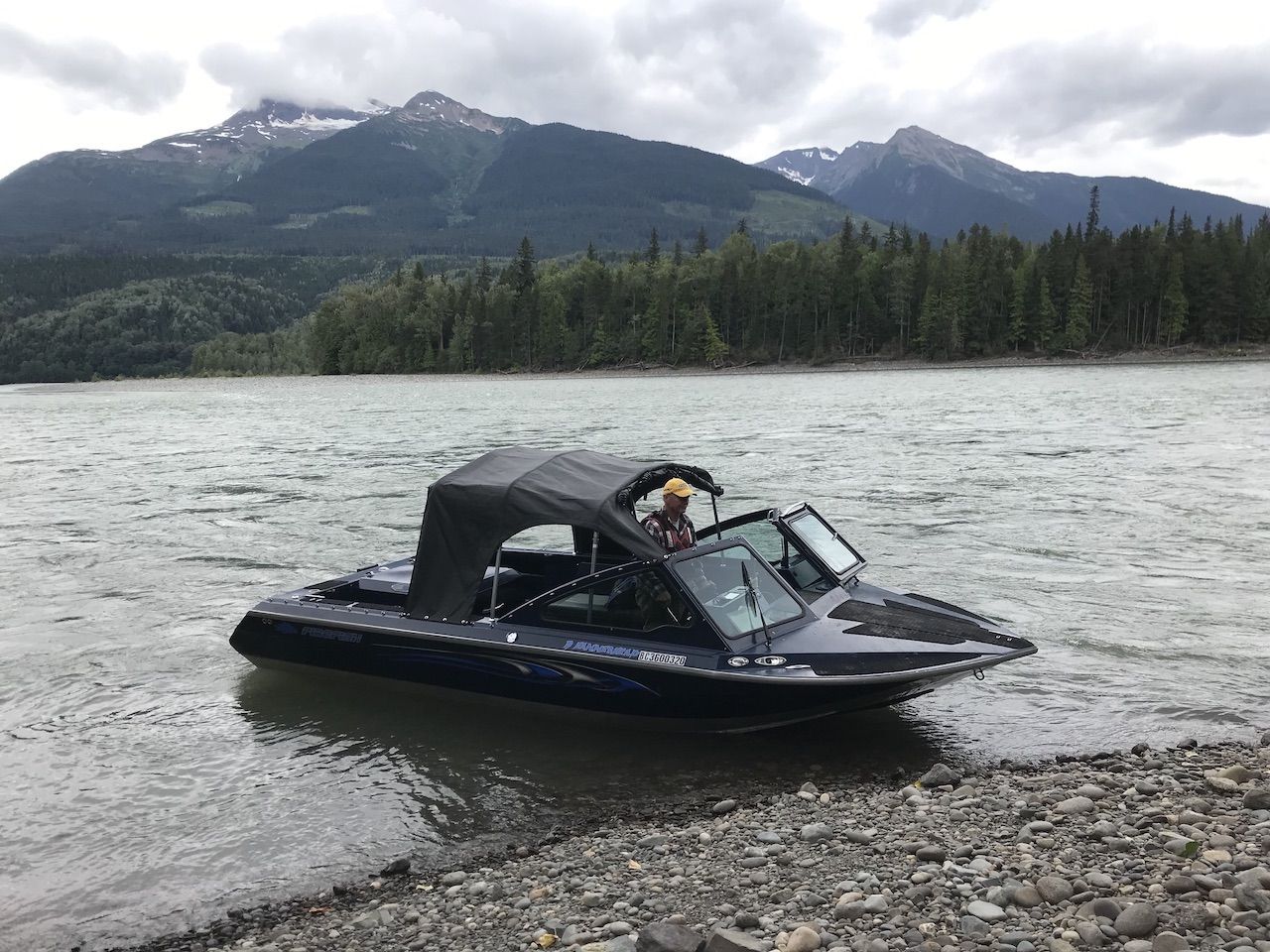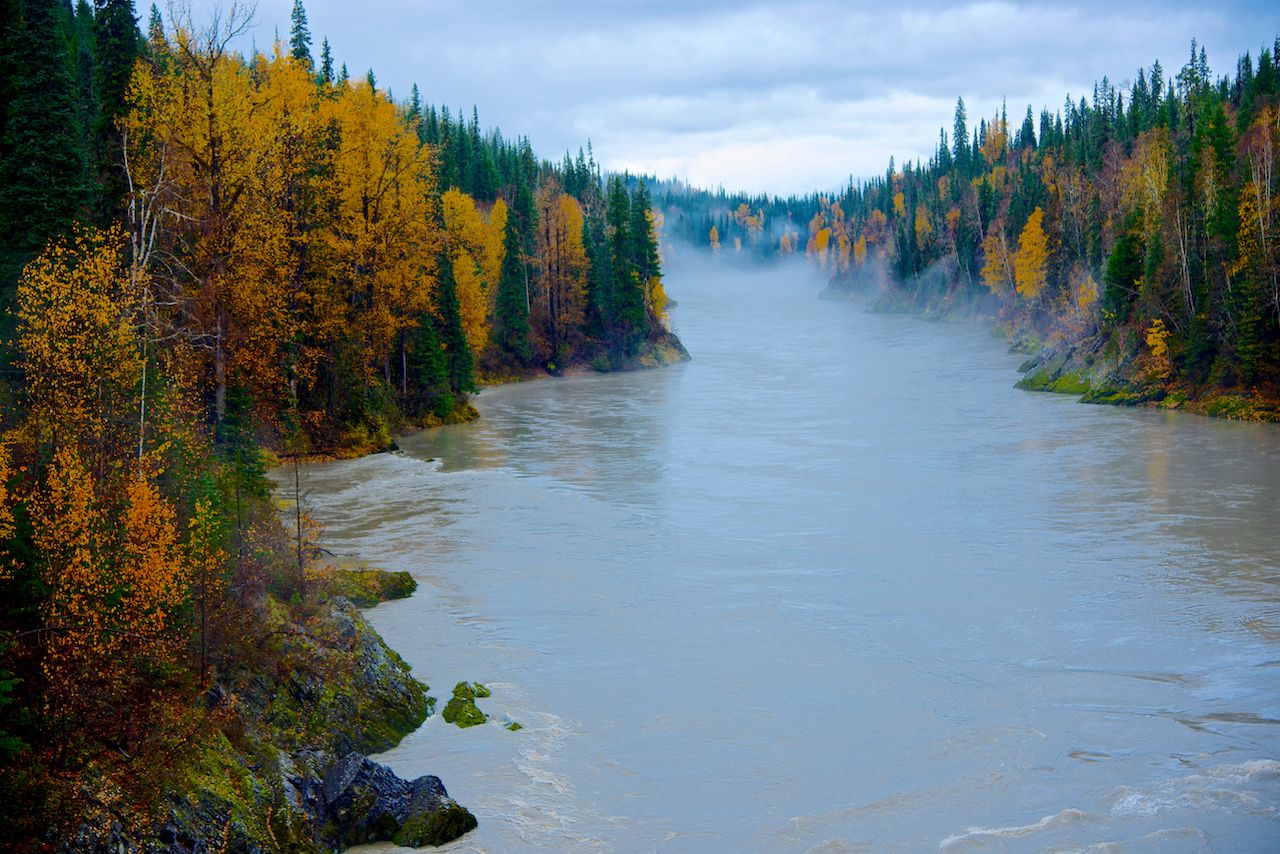The Skeena River slices through northern British Columbia, serving as an important lifeline for the communities along its banks from the headwaters in the Spatsizi Plateau until it spills into the Pacific Ocean 350 miles downstream. The Skeena’s deep turquoise water contrasts with the bright riverside flora and the dark, earthy hues of the Babine Range peaks beyond.

Through Outdoors Tourism, Northern BC's First Nations Build a Sustainable Economic Driver
You might not run into too many people in these parts, but seemingly everyone you do meet isn’t shy to tell you their story around the dinner table. Or the pool table, campfire, or anywhere else you happen to cross paths. The stories are often of the Skeena, the Kispiox, or the Nass rivers, and of the four annual salmon runs that flood these waterways with the area’s primary source of protein. There are stories of survival in this rugged landscape and of the people who have excelled at doing so.
For those seeking an escape from urban life, Northern BC is the ideal destination. Ask a resident in Smithers where the nearest Target or Apple store is and you’re going to get a blank stare, maybe a finger pointing south. The region is not for people who aren’t keen to spend time outdoors, and no one around here seems eager to change that. But if you’re up for real adventure in BC, head to The North. Here’s how to make the most of it.
Get out on the water and visit the Kitseguecla Nation.

Photo: Tim Wenger
The best way to see the natural diversity of Northern and Central BC is to hop on a jet boat on the Skeena. If you’re unfamiliar with these small, minimalist vessels, Rob Bryce of Northern BC Jet Boat Tours treaty is happy to fill you in.
“It’s basically a big vacuum cleaner,” he explains. “It sucks up water in the front and spits it out the back. They’re designed for rivers, for the rapids we run through.” With that, Fred Seiler ripped the motor. The boat stood on its rear and shot forward through the whitewater, skidding by the rocky bank downriver tow. Tours can run anywhere from an hour to a full day, covering well-known — at least locally — rapids including the Whirligig, Beaver Dam, and Devil’s Elbow. If you’re lucky, your tour will pass by the Kitseguecla Nation land.
As the boats wind south, the smell of smoked salmon becomes increasingly stronger. Many Kitseguecla Nations families smoke their own salmon. Some families smoke for trade or sale, but all smoke for self-nourishment.

Photo: Tim Wenger
All visitors to Kitseguecla Land — there aren’t many — are brought ashore to the Nation’s traditional song of welcome. Just off the riverbank, their village is an expansive settlement whose story is told by the many totem poles throughout town; many of these poles are in the yards of residents, others in open areas.
Also in the village are the small smokehouses, which many families have in their yards — essentially wooden shacks complete with hooks and a gutting table. After being gutted and fileted, the fish are hung for two to three days in these structures, with the fire going continuously. Some in the younger generation have taken to adding spices or candying the salmon, but others keep it straightforward. Just fish, smoke, and time. The guts go back in the river.
“It’s unacceptable to dump the guts anywhere else,” said Clyde Williams, Hereditary Chief of the Kitseguecla’s Owl Clan and the master songster who welcomed us ashore. “The belief is that this keeps the fish coming back.” Williams, quite possibly Northern BC’s most prolific storyteller, tells us about his preferred method for smoking and vacuum sealing Dungeness Crab. He says that when you sauté it months later, it tastes fresher than anything the grocery store might pass off as a recent catch.
It’s not just salmon that run these waters, and Williams provided a full tour of his smokehouse operation in session. The smokehouses, as with the Nation’s other fishing and harvesting practices, are part of the Kitseguecla’s sustainable way of life.
“If the lights went off all over the world, there would be chaos in Vancouver. Chaos in Calgary. But here, we wouldn’t even notice the difference,” Williams said. “The key to protecting our culture is teaching people to be connected to the land. With that comes an understanding of how important the traditions are.”
Although there aren’t yet a lot of visitors, and those who do come shouldn’t show up unannounced, the Nation is embracing local tour guiding. It believes that by inviting more people to experience their traditions firsthand, interest in preserving them will continue.
Spend a few days in the Nass River Valley.

Photo: Danita Delmont/Shutterstock
Even more captivating than the landscape of The North, as the region surrounding Smithers and north of BC Highway 16 is referred to by nearly everyone in or around it, are the stories you’ll hear told here. Although five million people live in British Columbia, only 250,000 of them reside in the top two-thirds of the province.
Absorbing the feel of The North is a tall task, one that is impossible to understand without visiting First Nations territory. Here, you’re guaranteed to learn something that questions your understanding of our own country’s history, as well as something that inspires hope for the future.
On May 11, 2000, the Nisga’a Final Agreement between the Nisga’a Nation and the Canadian government handed over 745 square miles of land back to the nation’s governing body after more than a century of negotiation, ceding control of not only their land but their traditions and way of life. Nothing is perfect, but a solid path forward has been drawn by the efforts of the Nations in conversation with the government in Ottawa.
Even the least discerning eye wouldn’t need to squint to take in the beauty of their land, and for the first time since the 1800s, federal oversight is almost naught, to the point that it has its own school system and its own medical system, complete with doctors and nurses living and working in the areas they serve. The governing bodies also have the ability to tax revenue from private mining operations on their land which has, along with trust money set aside following the treaty, put the Nisga’a in a positive financial position to invest in outdoor recreation and tourism.

Photo: Feng Yu/Shutterstock
The Nass River Valley where the Nisga’a live is ripe with opportunities for outdoor recreation. The local economy is working to harness this as a sustainable means of long-term revenue and employment, and your tourism dollars in the area go a long way to making that happen.
“We have a program called the Nisga’a Business Development Fund that helps young entrepreneurs,” said Bertram Mercer, the Nisga’a Lisims Government’s Economic Development Manager. “We’re in pilot mode right now to determine what kind of businesses can be run here. Fishing boats are viable, and we know there are others.”
Native-owned businesses in the incubator receive not only funding assistance but also mentorship and connections, and the results of the new fund are already evident. Young people are sticking around instead of moving down to the big cities near the US-Canada border, and more of those who moved away to find work elsewhere are coming back to start businesses in their hometown.
Many of these businesses are built around the land that provides their sustenance, such as Reel North Adventures, which leads visitors on guided salmon, trout, and steelhead expeditions on the surrounding rivers. Rather than ditching long-standing tradition, First Nations customs are prioritized from a young age, with special attention given to traditional language and cultural ceremonies. “We teach the language and culture right from preschool,” said Mercer. “They learn the language right away.”
To familiarize yourself with the area, take a day and drive the Nisga’a Nation Auto Tour along Highway 113. Stop along the way to hike the mile in from Crater Creek at the Nisga’a Memorial Lava Bed Provincial Park, the first park jointly managed by both a First Nations and BC Parks. You’ll hike across volcanic lava that still covers a stretch of the mountainous landscape with black, pumice-like rock called “Aa,” even though the last volcanic eruption was 2,000 years ago. After the hike, stop by Nass Valley Hot Springs for a soak. Then, to learn more about the treaty and the impact is has had on the Nisga’a Nation, visit the Nisga’a Museum.
Explore other outdoor activities.

Photo: Tim Wenger
Driving from Vancouver to Smithers takes about 12 hours of road time, and spending a night in Prince George is a good way to break up the drive. Most convenient, though, is flying in. Local airports in Smithers and Terrace offer connections from Vancouver, Kelowna, and other regional hubs.
You can base some of your time in either Smithers or Terrace, exploring the region’s trails by foot and by mountain bike. Adventure Camp Tourism in Smithers runs mountain bike shuttles and leads guided rides and hikes. The city’s tourism website offers an extensive list of nearby trails and routing information if you want to brave it on your own. Be forewarned, though: You’ve likely heard the term “bear country” before, and Northern BC epitomizes the phrase. It’s not uncommon to see black and even grizzly bears crossing the road, and while seeing them on the trail is rare, precautions — like carrying bear spray — should be taken.
In winter, Hudson Bay Mountain is the local ski hill. Backcountry users can explore the Hankin-Evelyn trail system, one of the few backcountry ski areas where runs are actually cut into the mountains, though you still have to earn your turns before you can take them. Helicopter and cat-skiing options abound, with services from Skeena Heliskiing.
Get off the grid.

Photo: Anna Dunlop/Shutterstock
You’ve made it this far north; you might as well go all in and get off the grid for a few days. The Nisga’a Nation is inspiring other sustainable tourism models in the area. Tourism businesses throughout the region are working to follow the lead of First Nations communities, crafting off-grid experiences within the region’s mountains and waters to highlight the importance of protecting them.
Bearclaw Lodge is a prime example. Located along the Kispiox River two hours north of Smithers, the off-grid lodge falls somewhere between rustic cabin and luxury retreat, powered by rooftop solar panels and operating in a manner that necessitates all-inclusive service. In summer, those solar panels can work long hours — since the sun set at 9:42 pm on July 25 — but the opposite is true in winter.
Bearclaw embodies everything the region offers. The in-house kitchen serves fish and game from the surrounding land and produce from the on-site garden. The lodge is a destination for backcountry skiing and snowboarding in winter and salmon fishing in autumn. Summer activities include kayaking the Kispiox, with occasional stops to snorkel for salmon or cast a line into the cool water.
“The land where the lodge now sits was originally owned by a German couple who refused to sell unless the horses stayed on the property,” said Kaleigh Allen, manager of the lodge and daughter of founders Gene and Jane Allen. “So the horses stayed.”
As such, horseback riding and hiking are on offer, as well, with helicopter access to high-altitude trailheads when weather permits. And, no, the weather doesn’t always permit. Everyone who has traveled in Canada is familiar with the term “weathered out.” Accessing the backcountry is often a waiting game. When clouds move in, you stay in, and if this happens, your best option is to cozy up in the lodge, soak in the hot tub, and converse with the Allen family in front of the fireplace.
Ask about the German Eye Sucker, a local legend who, through an unparalleled ability to suck the toxins of a hornet sting straight from the human body, saved the right eye of Bearclaw co-owner Jane Allen after an unfortunate hornet swarming incident. The Bearclaw Lodge, like The North as a whole, is the place you go to forget about lift lines and crowded trailhead parking lots because they’re not even a thing around here. You’re more likely to encounter a swarm of salmon or hornets than you are a group of people.
Back in civilization, pull up a stool at Smithers Brewing and join the conversation about fishing conditions or trail developments in the Hankin-Evelyn backcountry, miles of trail and river all to yourself, the luxury spas and high-end art galleries of Aspen nowhere to be found. Residents here are just fine with that. Bring open ears, an open mind, and your outdoor gear. Once you converge with the landscape of The North, it’s easy to forget that life south of Smithers even exists.